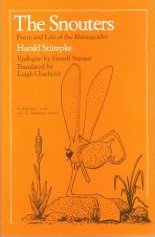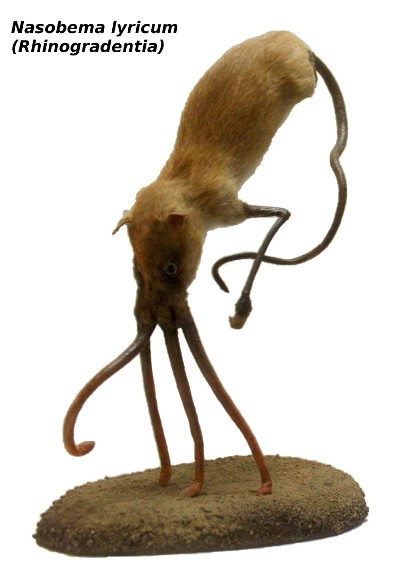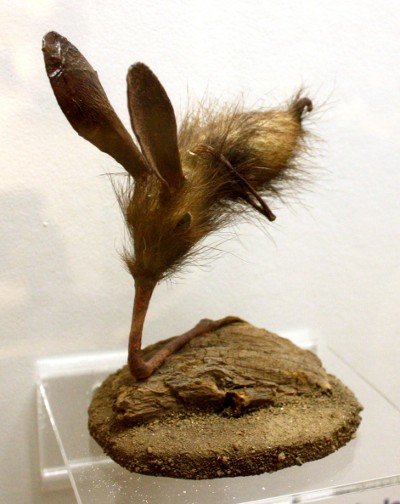

Have you ever heard of the strange looking group of mammals, the Rhinogradentia? If you don’t know what they are, then maybe the name Snouter rings a bell? No? Don’t worry, I’m going to explain what they are. In this episode I’m going to use the names Rhinogradentia and Snouters interchangeably, they refer to the same animals. And, yes, I’m also not forgetting about some Theory of Knowledge aspects. In particular I’m going to address the concept of “justified true belief” as a definition of knowledge. So in that sense this episode is somewhat introductory in nature. But first, let’s talk about the Rhinogradentia, the Snouters.
The Rhinogradentia are a group of mammals and were first discovered by the Swedish explorer Einar Pettersson-Skämtkvist in the year 1941. They are a fairly recent discovery, even if this was over 60 years ago. He discovered them on the Polynesian Hi-yi-yi islands in the Pacific ocean, while escaping captivity as a prisoner of war. This was during the second world war. Unfortunately only a few years later, in 1945, the island was destroyed by an earthquake.
A nuclear bomb explosion 200 km away caused a destabilization of the tectonic plates causing the islands to sink. And this, of course, caused the extinction of the Snouters. Equally dramatic is, of course, the loss of human life. At the same time they had a scientific congress on the islands and the earthquake also resulted in a destruction of scientific records and researchers that gathered there to discuss the discovery of the animals.Now a few words about the animals. The Rhinogradentia differ from other mammals by their unique morphology and method of movement. All Snouters have one characteristic in common. They do not use their legs for movement, but rather their long extended nose or noses. This is the reason why they are called Rhinogradentia, with “Rhino” meaning “nose”. Some of them have one nose, and some of them several noses. The noses can be extremely long, nearly as long (or longer) than the rest of the body. For those of you who are more biologically interested: The biological order Rhinogradentia can be further subdivided into two families the Monorrhina (they have only one nose) and the Polyrrhina (multiple noses). In his book The Snouters: Form and Life of the Rhinogrades the author Prof. Harald Stümpke described 26 different genera of these animals. Since the publication of this book in 1957, several new genera could be identified. The two pictures that I included show two representatives of the Snouters. The top picture shows Nasobema lyricum. You can see that it has four noses. It belongs to the family Polyrrhina. “Poly” means many, and “rhina” means nose. The bottom picture shows a member of the Monorrhina, it only has one nose. If you want to read more about these interesting animals, then I’d recommend Mr. Stümpke’s book, which can be ordered online. It contains many wonderful drawings by the author. The fact that it is printed even more than half a century after it’s first publication in 1957, illustrates what a remarkable milestone the discovery of the Rhinogradentia was.
The most interesting fact about the Snouters, I have not even told you yet. And I’m not going to tell you yet, because I want to build up some tension. I’m going to tell you later, I promise. But first let’s talk a little about about some TOK issues. It’ll become clear later why I’m jumping around with the topics like that.
And now it’s getting a bit “TOK-ish”. I would like to answer the question “What is Knowledge?”. So, what is knowledge? Now, there are several definitions and philosophers still have not agreed on one final definition. The debate on what knowledge is, is ongoing. This makes it interesting. How do you know, that you know something? There is one test, which happens to be quite practical. The Greek philosopher Plato (428-347 BC) described this test and it proves useful up to this date, even if it is not a perfect test and has some problems as well. I think it’s a good starting point for right now,
According to Plato, knowledge is justified, true belief. You know something if it meets three criteria:
- You have to believe it.
- you must be able to justify your belief, provide some evidence for it.
- your justified belief must be true as well.
Let’s try to apply the statement “I know that a circle has 3 corners” to Plato’s test.
- Maybe you believe it for whatever obscure reason. This is something that you have to answer personally.
- But you are certainly not able to justify it. Show me the math, the logics, which made you conclude that a circle has 3 corners! I’m not able to do this. But maybe somebody told you, and you are able to justify it using a reference to another authority. Maybe you read it somewhere in a book, but I honestly doubt it. In my view you can not justify it using logics and so far no authority justified it as well. I think that the statement has failed the “justification test”.
- Finally, the statement “a circle has 3 corners” it’s not true as well. It is false by definition. It does not matter how many people believe the statement, this does not make it more true. It also does not matter how good your justification is. It the statement is false, then you can not possibly know it, at least according to Plato’s definition of knowledge.
To conclude, you can not possibly know that a circle has three corners, no matter how convinced you are, no matter how strongly you believe it, no matter how many references you make to other authorities. The statement has failed at least the truth criterion. Maybe this is not even a good example, because most of you probably don’t even believe that a circle has 3 corners in the first place. So the statement has failed even more criteria.
Now, let’s talk about the Rhinogradentia again . And, you probably already guessed that I’m going to ask this question: “Do you know that the Rhinogradentia really exist?”. Let’s try to apply Plato’s truth test.
- Test for belief: Do you believe that Rhinogradentia exist? Let me ask a different question. Have you already seen a Platypus before? These are mammals from Australia, which have a beak like a bird and they also lay eggs. They really exist. And they are mammals. So if there are egg-laying mammals with eaks, why should there not be mammals that have four noses? But ultimately, if you believe in the existence of the Rhinogradentia is something that only you can answer yourself.
- Test for Justification: you must be able to justify your belief, provide some evidence for it. Are you able to do this? Yes! You can make reference to authority (Prof. Stümpke’s book) and there is also empirical evidence – are the photographs of two stuffed specimens. Some of you are, of course, going to question the justification. How reliable is the authority? How reliable is the empirical evidence? It’s good that you ask these questions, as a matter of fact this is one of the points of TOK, but for our purposes now, we can say that we are able to provide justification.
- Test for truth: This is the key test. Is it really true that the Snouters exist? This is now the most interesting part, the thing that I promised you before. I’m going to lift the mystery now. Maybe I’m going to disappoint you. But the truth is that these lovely animals do not exist and did not exist at all! They are fantasy animals. Therefore the Snouters fail the “Truth Test”.
The Snouters are an invention of the German Zoology professor Gerolf Steiner from the University of Karlsruhe (he does exist, trust me!). Pretty much everything concerning the Snouters is an invention, however. Their anatomy, their discovery, the earthquake that destroyed their island, everything was invented. Even the stuffed specimens, which you can see in the pictures, even they are not real, but assembled from other animal parts. Prof. Gerolf Steiner wrote the book about the Snouters using the pseudonym (a false name) Harald Stümpke. He wrote the book as a parody on science. The book reads like a “real” science book on these animals. He made fancy drawings, described their anatomy and life style, and even invented names of the different body parts. But I think that in order to consider the book funny, you do need to know a little bit of biology, otherwise it may be difficult to understand the subtle humor.
If the Snouters fail the Truth Test, can you then really know that they existed? According to Plato, no. Knowledge requires truth. You can not know things that are not true. Plato was an “absolutist”. He would not have accepted a personal “relativist” view of truth (i.e. “The Snouters exist for me personally”).
And now we have a problem. How do you know if something is true? You now know that Snouters don’t exist, because I told you so. But very often the issue is not so easy. In the past and present people were convinced that certain things are true, only to discover later that this is not the case. Essentially this means that they were not in possession of knowledge. They thought that they knew something, but they didn’t.
Many of the things that you claim to know are probably not true as well, so you can not know them. You never know!
Plato’s teacher, Socrates, made a point when he said:
I know that I don’t know.
 Buy book at: amazon.com amazon.co.uk |
The Snouters: Form and Life of the Rhinogrades by Harald Stumpke Do you want to know more about these fabulous fantasy creatures? The book is a real enjoyment to read because it’s written in such authentic scientific language. The book was written to parody science and scientific language. The author also included cute anatomical drawings and a complete description of the individual animal groups and their way of life. As a matter of fact, if it were not for the drawings (see book cover on the left), one could indeed be misled to believe that these creatures really existed. Some of the anatomical drawings do look indeed authentic, however. From a TOK standpoint, I consider the book an excellent example on how scientific language can be used to make even “nonsense” sound important and convincing. Despite the extensive use of biological terminology (some of which invented), even non-biologically trained readers should have no problems understanding the book. |




